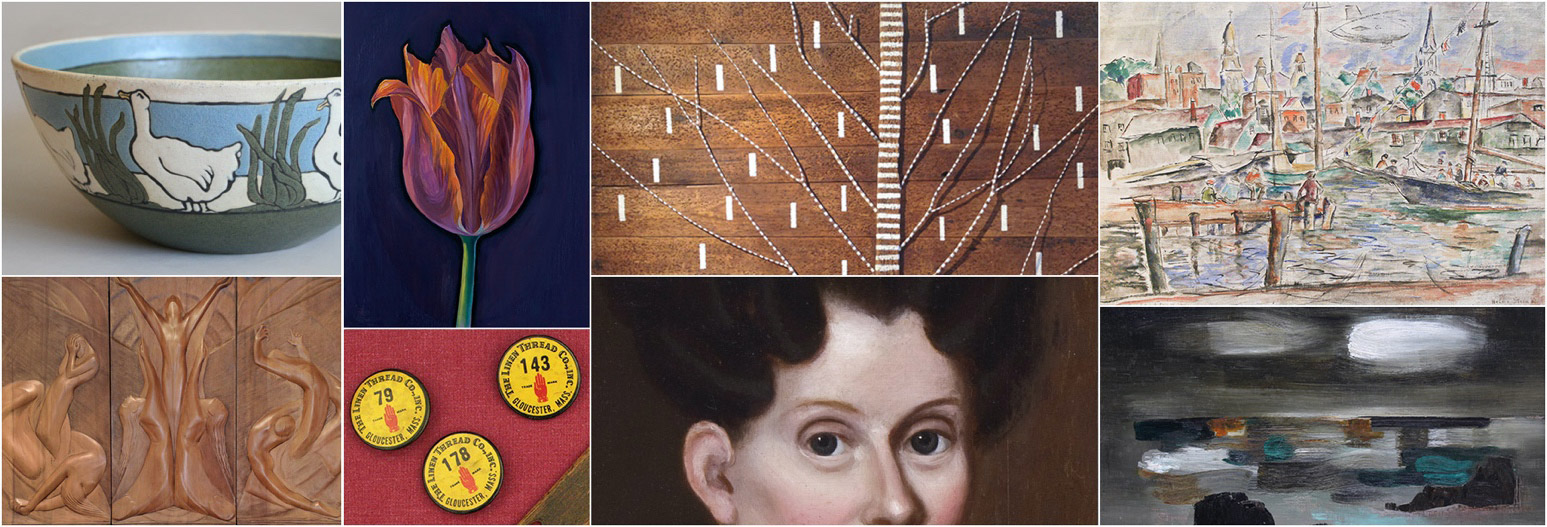
Dear Friends,
In this issue of CAM Connects, we celebrate Women’s History Month.
In Wednesday evening’s poignant Cape Ann Museum COVID-19 Memorial tribute, the three interconnected memorials presented at the Janet & William Ellery James Center and CAM Green were each created in partnership with local leading women artists. Through their work, these artists have created dedicated space and time to reflect upon what the Cape Ann, Essex County and broader national communities have endured throughout the pandemic. CAM is grateful for these powerful artists' voices who made this point of reflection possible.
Concurrently, at the Museum's Pleasant Street campus, the exploration of the role of women artists is further continued in the “Women of Cape Ann" section of our dynamic exhibition, CAM (Re)Connects, as well as in our online exhibit, Unfolding Histories.
Later this month, the Museum is honored to host two CAM Virtual Lecture Series events, one which explores how the painter John Singleton Copley represented women throughout his oeuvre and another lecture investigating the artistic career of sculptor Katharine Lane Weems. More information on this exciting programming can be found below.
Looking forward to seeing you at the Museum in the weeks ahead!
To book your visit, please click here.

Oliver Barker, Director
Above collage clockwise from upper left:
- Lili Shapiro (1894-1978), Goose Bowl, 1910, painted ceramic. Gift of Martin Whyte and Alice Hogan, 2015 [Acc. #2015.31]
- Barbara Swan (1922-2003), Madame Du Barry, 1971, oil on canvas. Gift of Robert L. and Elizabeth French, 2009 [Acc. #2009.51.3]
- Dawn Southworth, Ensuing Autumn, 21st century, wood, paint. Museum purchase, 2019, with funds provided by the Kanter Kallman Foundation [Acc. #2019.016]
- Helen Stein (1896-1964), The White Whale in the Sky [Gloucester from Rocky Neck], 1927, oil on canvas. Gift of James F. O'Gorman and Jean Baer O’Gorman, 2015 [Acc. #2015.57.14]
- Mary Shore (1912-2000), The Sullen Sea, undated, oil on panel. Gift of Brian Shore, 2001 [Acc. #2001.39.2]
- Susannah Paine (1792-1862), Hannah Fuller Smith Stanwood (1803-1834), 1834, oil on board.
- Linen Thread Company Badges owned by Amalia DaRosa Muniz (1891-1990). Gift of Tracie Lee, 2017 [Acc. #2017.019]
- Virginia Lee Burton Demetrios (1909-1968), Untitled, c. mid 20th century, carved wood. Gift of Aristides Burton Demetrios and Ilene Nagel Demetrios, 2019 [Acc. #2019.26.1]
Collection of the Cape Ann Museum, Gloucester, MA.
Women’s History Month
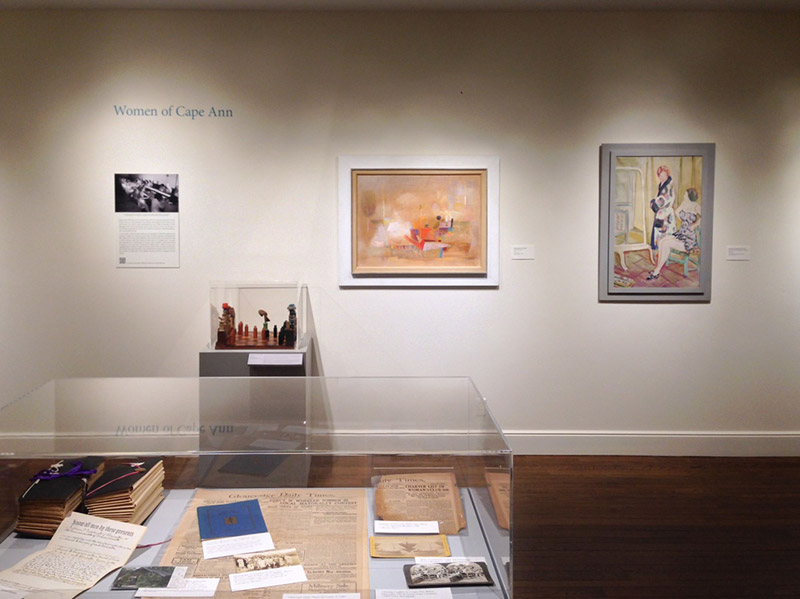
Gallery view of “Women of Cape Ann” section in current special exhibition, CAM (Re)Connects
Over the last 55 years, the Cape Ann Museum has made a concerted effort to expand our collection resulting in a strong representation of women artists. If you take a stroll through our galleries during women’s history month this year, you can find 59 works of art and 12 artifacts created by women currently on display.
From the large oil paintings of Margaret Fitzhugh Browne and Barbara Swan to the prints of Folly Cove Designers Virginia Lee Burton Demetrios and Louise Kenyon, and from the books by Nancy Gardner Prince and Elizabeth Stuart Phelps to the needles and buttons used by Amalia DaRosa Muniz, women’s art and stories are interwoven throughout the Museum.
Reserve a timed ticket to go on a treasure hunt and find all the art and artifacts currently on display! ■
Heritage & Tradition
Looking back through history on Cape Ann, the custom of a woman bringing a dowry or trousseau to her marriage was often related to the heritage of her family's country of origin and usually included items that would be useful to a woman’s future household while signifying a certain level of prosperity. In this section, we highlight two objects in CAM’s collection that were tied to the marriage of their respective owners: an engagement quilt from c. 1850 that was created for Georgianna Ellery upon her betrothal to William S. Friend, Jr., and a Hepplewhite sideboard from c. 1804 with Cape Ann roots that was passed down through four generations of mothers and daughters.
Engagement Quilt

Engagement Quilt, detail and full. Collection of the Cape Ann Museum, Gloucester, MA
This 170-year-old quilt has just returned to the Cape Ann Museum from Museum Textile Services in Andover, MA, where it underwent much needed conservation treatment. The work was underwritten with the generous support of Margaret Bernier, a Museum docent.
The quilt was made in Gloucester around 1850 by a group of women and presented to Georgianna Ellery (1829-1870) on the occasion of her marriage to William S. Friend, Jr. (1828-1912) in February 1852. Forty-two squares make up the piece which measures 105” x 90” overall. The pattern resembles that of the friendship star design. The center of each block was made of plain white fabric upon which messages were written in ink by each of the women who contributed a square to the quilt. The messages, each one signed and many of them dated, wished Georgianna well as she embarked on her new life as a wife and a mother.
Georgianna Ellery Friend was born in Gloucester, a daughter of Hannah Procter Ellery and George Ellery. As is the case with many women of the time, little is known about the details of Georgianna’s life beyond that she and her husband (who was a cooper) remained in Gloucester after their wedding and that she gave birth to three sons: Edward, Epes and Ray. In February 1870, Georgianna died giving birth to her fourth child, a girl who was stillborn. Ten years later, William Friend remarried.
The provenance of this remarkable quilt remains undetermined; its donor and the date of its donation to the Cape Ann Museum are unknown.
Hepplewhite Sideboard
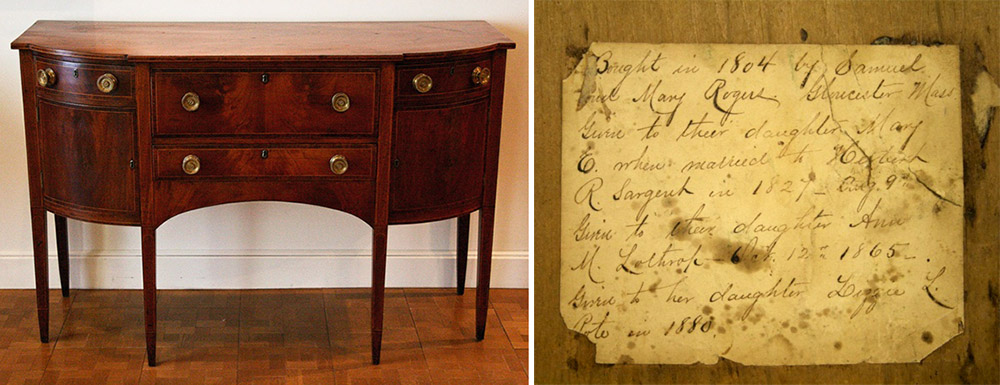
Left: Unattributed, Hepplewhite Sideboard, c. 1804, mahogany and brass with inlay. Collection of the Cape Ann Museum, Gloucester, MA. Gift of Roswitha and William Trayes, 2012 [Acc. #2012.38.1]. Right: Interior Detail.
This Hepplewhite sideboard currently on view in the Lane Gallery was made on the North Shore and originally owned by Samuel and Lucy (Foster) Rogers of Gloucester; it was acquired by them at the time of their marriage in 1804. Adhered inside one of the drawers, a slip of paper records the passage of this piece from mother to daughter through four generations. ■
Robey Benson aboard the Debbie Rose
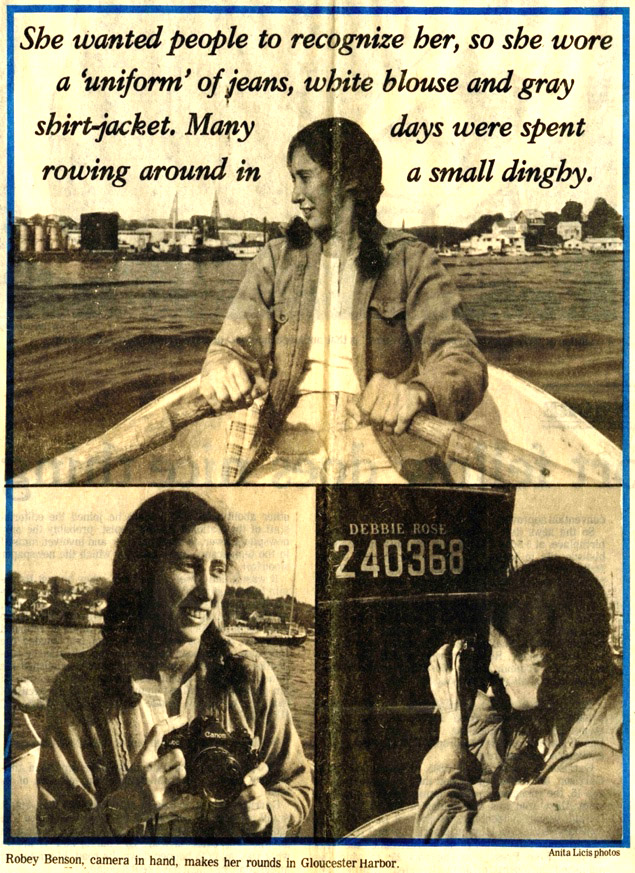
Clipping from Essex County Newspapers insert, December 1, 1979. Photographs by Anita Licis. Private collection.
In late 1979, Essex County Newspapers ran a full-page article on a young woman named Roberta (Robey) Benson, a photography student at Goddard College who was working on a photo essay towards her degree. Ms. Benson had a desire to “find out more about fishing and fishermen, especially what makes them keep on going out, day after day after day, despite the constant danger, the drudgery, and the high cost of maintaining a boat.” That desire led Robey to Gloucester in the summer of 1979 in search of a fishing vessel to take her out to sea so she could capture and document what a day’s work entailed. Despite being told she would never be invited by an experienced commercial fishing captain onto their vessel, Robey was resolute. Her strategy could be summarized as determination and assimilation. Each morning Robey stationed herself either at the pier or out in a dingy, wearing her "uniform," the importance of which cannot be overlooked. Robey seemed to have a clear understanding that modeling the routines of the fishermen would impact their recognition of her. The strategy paid off, and in a short period of time the fishermen began to not only notice but also acknowledge her. This, in tandem with her extensive maritime research at the library and bookstores and a chance meeting with Jack Farrell, director of the Gloucester Fishermen’s Museum, finally secured for her an August 2nd trip out on the Debbie Rose.
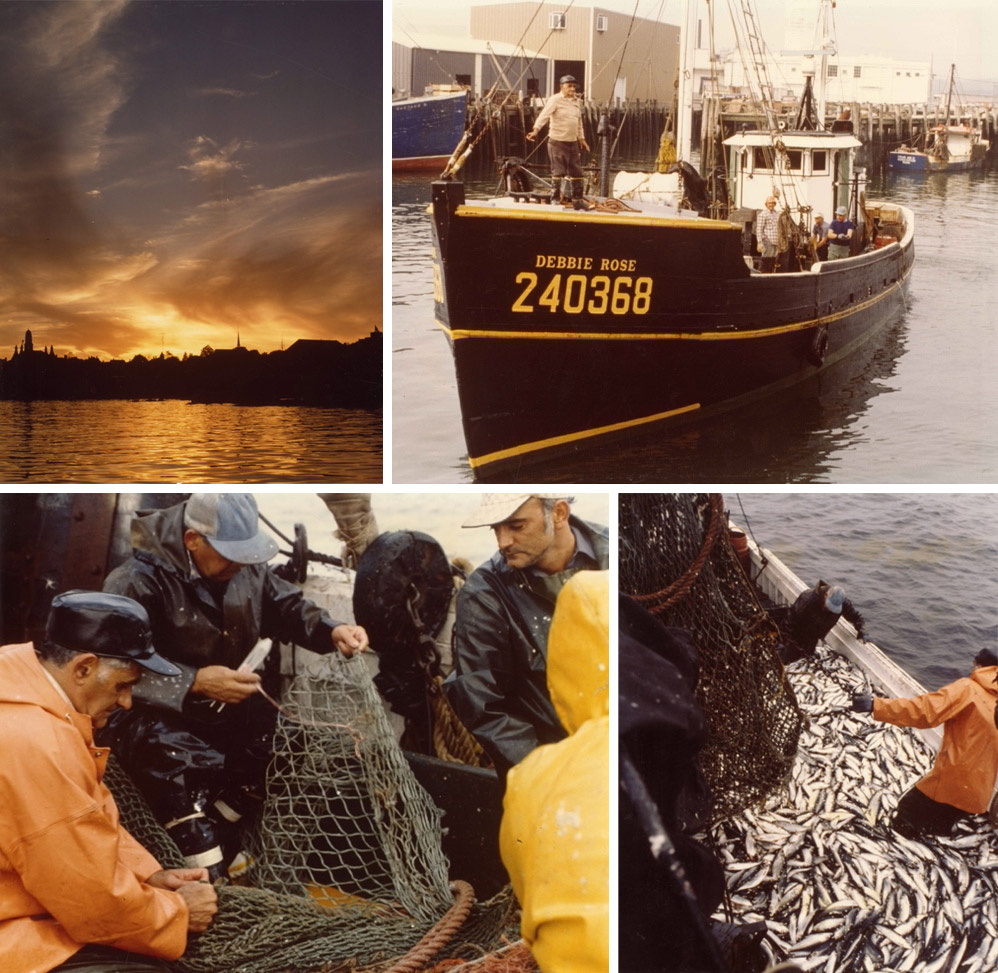
Aboard, and of, the fishing vessel Debbie Rose, August 2, 1979. Photographs by Roberta (Robey) Benson. Collection of the Cape Ann Museum, Gloucester MA. Gift of Gloucester Fishermen's Museum, 1993 [Acc. #2894.1].
The above photos are just a small sampling of the amazing captures that day, both photography and herring. A few images from this shoot are almost pitch black, emphasizing that Robey did not ask for special treatment or cause any inconvenience, but rather adapted to the fishermen’s hours and went out before dawn. Many more photographs show the vessel on its way back to harbor with the men now comfortable and smiling. The success of the day resulted in a photography exhibit at the Gloucester Fishermen’s Museum, which had crew members remarking, “That’s it. That’s just the way we do it!”
When this story was recently
shared with the Museum by community member Lee Swekla, whose father was a crew member, cook, and mender of nets on the Debbie
Rose, we searched our catalogs to see if we had any further information or
photographs by Robey Benson. An initial search unfortunately came up empty. A
few weeks later, an unrelated inquiry came in regarding the vessel, and low and
behold, Robey's photos came up in a search under the name "Robert Benson." It seems that when
the Fishermen's Museum materials were donated to the CAM Library & Archives,
long past Robey's 1979 exhibit, the writing and assumption was that "Roberta" was actually "Robert."
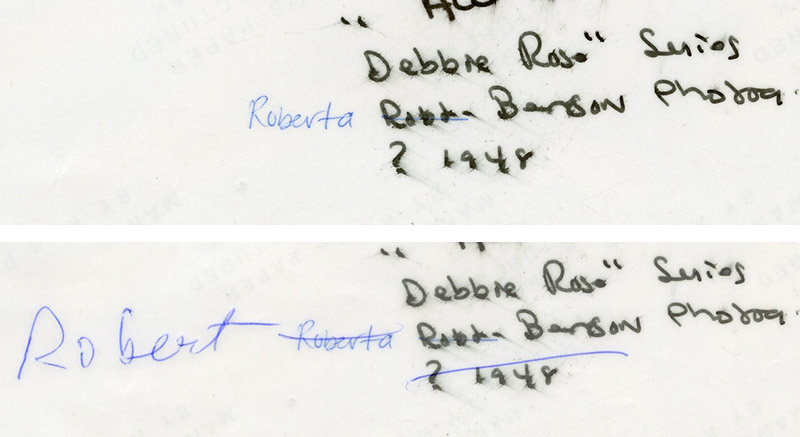
Seen here are a few stages of attempting to correct and re-correct this error over the years. The black pen is the first captioning, seemingly reading as “Robt.” or perhaps even “Robda” Benson. Then, in the top image, you can see the correction of “Roberta” – the bottom image shows the same photograph verso, but with the mylar sleeve placed back on, it incorrectly reverts back to “Robert”. Each photograph in the collection has a variation of this battle. From there, the incorrect “Robert” was added as metadata to the digital versions. The reader will be pleased to know that Roberta's photographs are now rightfully credited to her in all our systems, and she is now recognized as an important female photographer in our collection. ■
CAM Virtual Lecture Series 2021
How Copley Painted Women
Friday, March 19th at 4:00 p.m. on Zoom
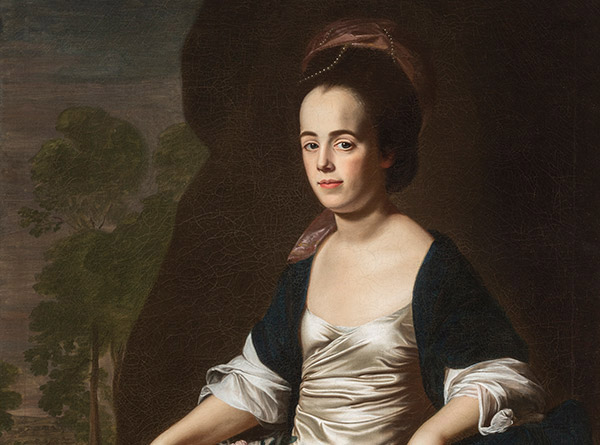
John Singleton Copley, American, 1738–1815. Portrait of Mrs. John Stevens (Judith Sargent, later Mrs. John Murray), 1770–72, oil on canvas (50 x 40 in. unframed). Terra Foundation for American Art, Daniel J. Terra Art Acquisition Endowment Fund. Photography ©Terra Foundation for American Art, Chicago. [Detail].
In honor of Women’s History Month, the Cape Ann Museum welcomes historian Jane Kamensky from Harvard University and curator Erica Hirshler from the Museum of Fine Arts, Boston, to discuss how—and even why—the American portrait artist John Singleton Copley painted women.
Beginning with John Singleton Copley’s 1770-72 oil portrait of Judith Sargent Murray, currently on view at the Cape Ann Museum in collaboration with the Terra Foundation for American Art and the Sargent House Museum, Kamensky and Hirshler will discuss a series of paintings that Copley made of women—young and old—in Boston and in London in the mid to late eighteenth century. ■
For more information and to register, click here.
Proving Her Metal:
The Life and Sculpture of Katharine Lane Weems
Wednesday, March 31 at 5:30 p.m. on Zoom
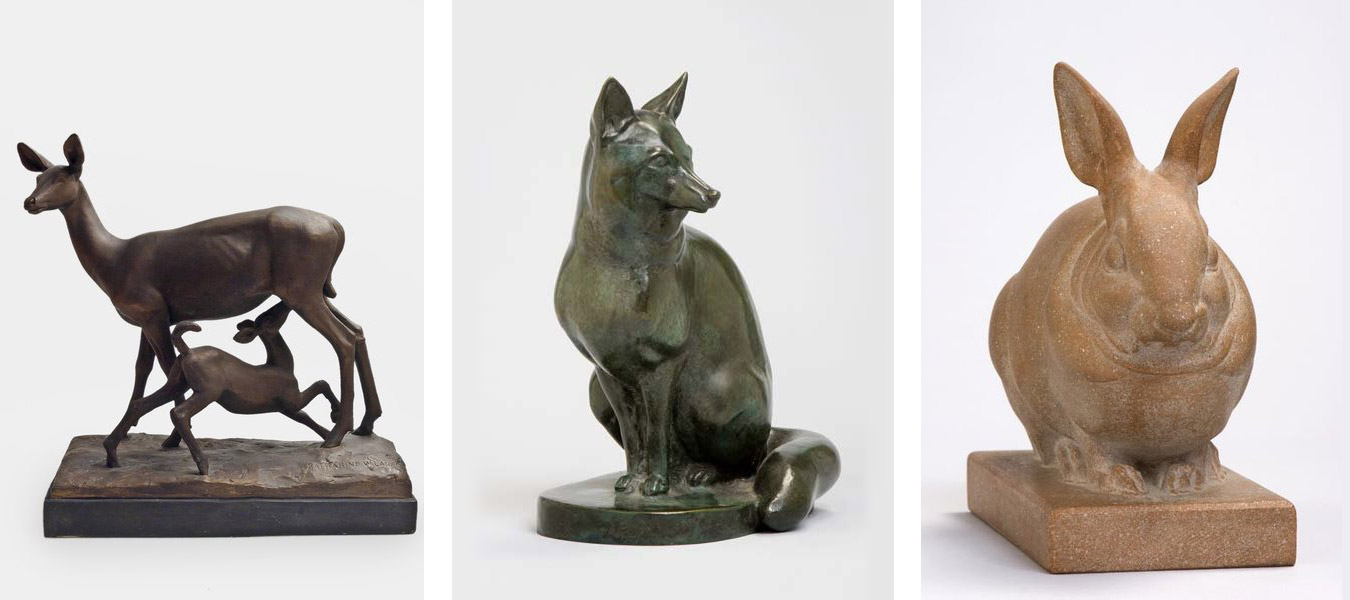
Left to right: Katharine Lane Weems (1899-1989), Doe and Fawn, 1927, plaster. Gift of the estate of Walker Hancock, 2001 [Acc. #2001.27.14]; Grey Fox, 1971, bronze. Gift of the artist, 1984 [Acc. #2407]; Rabbit, undated, cast stone. Gift of Walker Hancock, 1989 [Acc. #2623]. Collection of the Cape Ann Museum, Gloucester, MA.
Historically, it has not been easy for women to be recognized as professional artists. As Walker Hancock said in his foreword to Katharine Lane Weems’ 1985 memoir, Odds Were Against Me, “A young woman entering an art class had to prove her mettle. An instructor could be forgiven for wondering whether she could ‘stand the gaff,’ as the expression was." This makes the success of sculptor Katharine Lane Weems (1899–1989) all the more impressive.
In this virtual lecture, Manship Artists Executive Director Rebecca Reynolds will explore the life and work of Weems. Reynolds will be joined by Jonathan Fairbanks, Katharine Lane Weems Curator Emeritus, MFA Boston, and Robert Shure, sculptor and proprietor of Skylight Studios who worked with “Kay” as a young man and helped her create work in her late age. As part of their conversation, CAM Staff will provide a live view of several of Weems’ sculptures and Charles Hopkinson’s 1920 portrait of Weems, currently on loan from Tufts University Art Gallery. ■
For more information and to register, click here.
Unsubscribe | Forward | View in browser
CAPE ANN MUSEUM
27 Pleasant Street, Gloucester, MA 01930
CAPE ANN MUSEUM GREEN
13 Poplar Street, Gloucester, MA 01930
Cape Ann is one of the most important places in the history of American art and industry.
The Cape Ann Museum, thanks to supporters like you, celebrates the history and remarkable contributions of this place to the cultural enhancement of our community and the world at large - yesterday, today and tomorro


